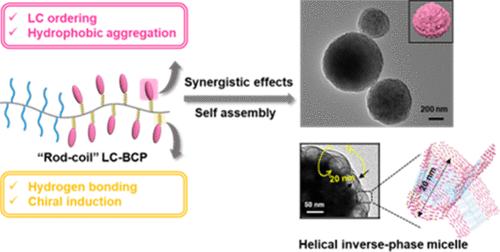Colloidal Helical Inverse-Phase Assemblies Constructed by Liquid Crystal Block Copolymer with Tunable Chiral Amino Acid Spacers
IF 5.2
1区 化学
Q1 POLYMER SCIENCE
引用次数: 0
Abstract
Inverse-phase micelles have been extensively studied due to their high porosity, large specific surface area, and structural versatility. However, the construction of inverse-phase assemblies from anisotropic polymers driven by complex synergistic interactions has largely been underexplored. Here, we report a class of cholesterol-based block copolymers (BCPs), POEGMAm-b-P(R)Choln (R = Ala, Leu, Phe), featuring chiral amino acid moieties as side-chain spacers and liquid crystalline (LC) cholesterol as mesogenic units. The integration of chirality and liquid crystallinity imparts unique anisotropic properties to these BCPs, enabling synergetic interactions between hydrogen bonding, LC ordering, and hydrophobic aggregation during self-assembly. Notably, the chirality of the amino acid spacers is preserved within the micellar structure and effectively transmitted during the self-assembly process, resulting in the formation of inverse-phase micelles with pronounced helicity. These findings highlight a versatile strategy for constructing inverse-phase nanostructures with helicity and complexity by leveraging the synergistic effects of chirality and LC order within block copolymer frameworks.

具有可调手性氨基酸间隔剂的液晶嵌段共聚物构建的胶体螺旋反相组装体
由于其高孔隙率、大比表面积和结构通用性,反相胶束得到了广泛的研究。然而,由复杂的协同作用驱动的各向异性聚合物的反相组件的构建在很大程度上尚未得到充分的探索。在这里,我们报道了一类基于胆固醇的嵌段共聚物(bcp), POEGMAm-b-P(R)Choln (R = Ala, Leu, Phe),具有手性氨基酸部分作为侧链间隔剂和液晶(LC)胆固醇作为介生单位。手性和液态结晶度的结合赋予了这些bcp独特的各向异性,使自组装过程中氢键、LC排序和疏水聚集之间的协同作用成为可能。值得注意的是,氨基酸间隔剂的手性被保留在胶束结构中,并在自组装过程中有效地传递,导致形成具有明显螺旋度的反相胶束。这些发现强调了通过利用嵌段共聚物框架内手性和LC顺序的协同效应来构建具有螺旋度和复杂性的反相纳米结构的通用策略。
本文章由计算机程序翻译,如有差异,请以英文原文为准。
求助全文
约1分钟内获得全文
求助全文
来源期刊

Macromolecules
工程技术-高分子科学
CiteScore
9.30
自引率
16.40%
发文量
942
审稿时长
2 months
期刊介绍:
Macromolecules publishes original, fundamental, and impactful research on all aspects of polymer science. Topics of interest include synthesis (e.g., controlled polymerizations, polymerization catalysis, post polymerization modification, new monomer structures and polymer architectures, and polymerization mechanisms/kinetics analysis); phase behavior, thermodynamics, dynamic, and ordering/disordering phenomena (e.g., self-assembly, gelation, crystallization, solution/melt/solid-state characteristics); structure and properties (e.g., mechanical and rheological properties, surface/interfacial characteristics, electronic and transport properties); new state of the art characterization (e.g., spectroscopy, scattering, microscopy, rheology), simulation (e.g., Monte Carlo, molecular dynamics, multi-scale/coarse-grained modeling), and theoretical methods. Renewable/sustainable polymers, polymer networks, responsive polymers, electro-, magneto- and opto-active macromolecules, inorganic polymers, charge-transporting polymers (ion-containing, semiconducting, and conducting), nanostructured polymers, and polymer composites are also of interest. Typical papers published in Macromolecules showcase important and innovative concepts, experimental methods/observations, and theoretical/computational approaches that demonstrate a fundamental advance in the understanding of polymers.
 求助内容:
求助内容: 应助结果提醒方式:
应助结果提醒方式:


